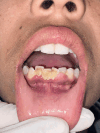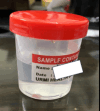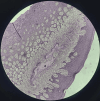Reactionary Bone Changes in Long-Standing Pyogenic Granuloma: A Case Report
- PMID: 38410319
- PMCID: PMC10895205
- DOI: 10.7759/cureus.53021
Reactionary Bone Changes in Long-Standing Pyogenic Granuloma: A Case Report
Abstract
Pyogenic granuloma is a reactive lesion that is commonly seen in the skin and oral cavity. Though it is an unfortunate misnomer, being neither pyogenic nor a true granuloma, the name has been used for years. In the oral cavity, it presents as a growth mostly situated on the gingiva, but may also occur on the tongue, buccal and labial mucosa, and palate, and may even be seen in relation to dental implants. The lesion is usually bright or purple red in color, soft in consistency, relatively painless, and appears highly vascularized. Local etiologic factors are usually poor oral hygiene or chronic irritation. Histopathologically it is an inflammatory hyperplasia of the connective tissue with exuberant vascularity. Sometimes, this lesion may present with unusual histopathological patterns, which could lead to difficulty in diagnosis. Long-standing pyogenic granuloma may show histologic changes such as localized osteogenesis in the matrix of the lesion which could potentially lead to complications in the area of the lesion. This article reports a rare case with rare histopathological features in an 18-year-old female presenting with long-standing soft tissue gingival growth.
Keywords: exophytic; osteogenesis; pyogenic granuloma; trabeculae; vascular.
Copyright © 2024, Lalremtluangi et al.
Conflict of interest statement
The authors have declared that no competing interests exist.
Figures




Similar articles
-
A Clinical Report of Solitary Gingival Overgrowth in a Young Female Patient.J Pharm Bioallied Sci. 2019 May;11(Suppl 2):S491-S494. doi: 10.4103/JPBS.JPBS_8_19. J Pharm Bioallied Sci. 2019. PMID: 31198394 Free PMC article.
-
Extragingival Pyogenic Granuloma: an Unusual Clinical Presentation.J Dent (Shiraz). 2015 Sep;16(3 Suppl):282-5. J Dent (Shiraz). 2015. PMID: 26535410 Free PMC article.
-
Pyogenic granuloma of the gingiva: A misnomer? - A case report and review of literature.J Indian Soc Periodontol. 2013 Jul;17(4):514-9. doi: 10.4103/0972-124X.118327. J Indian Soc Periodontol. 2013. PMID: 24174735 Free PMC article.
-
Oral pyogenic granuloma: a review.J Oral Sci. 2006 Dec;48(4):167-75. doi: 10.2334/josnusd.48.167. J Oral Sci. 2006. PMID: 17220613 Review.
-
Heterogeneous conceptualization of etiopathogenesis: Oral pyogenic granuloma.Natl J Maxillofac Surg. 2019 Jan-Jun;10(1):3-7. doi: 10.4103/njms.NJMS_55_18. Natl J Maxillofac Surg. 2019. PMID: 31205381 Free PMC article. Review.
References
-
- Sarwal P, Lapumnuaypol K. Treasure Island, FL: StatPearls Publishing; 2024. Pyogenic Granuloma. - PubMed
-
- Pyogenic granuloma: evaluation of oral conditions. Vilmann A, Vilmann P, Vilmann H. Br J Oral Maxillofac Surg . 1986;24:376–382. - PubMed
-
- Oral pyogenic granuloma: a review of 137 cases. Saravana GH. Br J Oral Maxillofac Surg. 2009;47:318–319. - PubMed
Publication types
LinkOut - more resources
Full Text Sources
